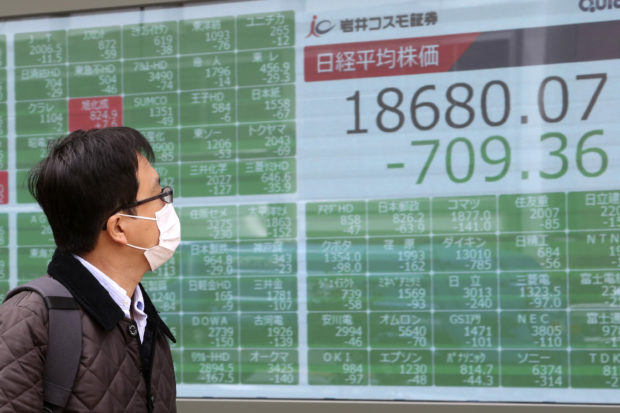TOKYO — Asian shares rose Tuesday although investors were braced for a sobering first look at how the coronavirus pandemic has hurt global corporate earnings and the Chinese economy, the driver of growth for the region.

A man looks at an electronic stock board of a securities firm in Tokyo, Monday, March 30, 2020. Asian shares started the week with further losses as countries reported surging numbers of infections from the coronavirus that has prompted shutdowns of travel and business in many parts of the world.(AP Photo/Koji Sasahara)
Japan’s benchmark Nikkei 225 added 2.2% in morning trading to 19,471.77. Australia’s S&P/ASX 200 gained 0.6% to 5,421.50, while South Korea’s Kospi jumped 1.4% to 1,850.83. Hong Kong’s Hang Seng edged up 0.4% to 24,399.68, and the Shanghai Composite added 0.5% to 2,797.96.
Market players are were awaiting Chinese trade data for March. The customs agency in Beijing said exports fell 3.5% in Chinese currency terms to 1.3 trillion yuan ($183 billion). It didn’t immediately report figures in U.S. dollars, in which all of China’s trade is conducted, or give a year-on-year comparison, its standard measurement of growth.
Exports sank 17.2% in February in U.S. dollar terms as anti-virus controls closed factories, shopping malls and other businesses. The customs agency said trade will face further pressure due to weakness in the global economy.
On Wall Street, the S&P 500 fell 1% after cutting early losses by more than half toward the end of the day. The benchmark index surged 12% last week, its best gain since 1974.
Financial, industrial and health care stocks took some of the heaviest selling. Amazon and a few other retailers were bright spots. Traders continued to watch for more signs that the coronavirus outbreak may be leveling off and what that could mean for the prospects of reopening the economy.
Cautious optimism that the outbreak has begun to plateau in some of the worst-hit areas and another big infusion of economic support by the Federal Reserve helped spur last week’s big rally. This week, stocks could be in for more volatility as companies report results for the first quarter, though analysts will be focused primarily on what management teams have to say about what the rest of the year looks like.
Details may be hard to come by, as many companies have ceased giving earnings forecasts because of the uncertainty over when government officials will determine it’s safe to roll back the social distancing and stay-at-home mandates that have all but ground the economy to a halt.
“The companies don’t know what demand is going to be over the next three months or over the next six months,” said Willie Delwiche, investment strategist at Baird.
The S&P lost 28.19 points to 2,761.63. The Dow Jones Industrial Average fell 1.4% to 23,390.77. The Nasdaq rose 0.5% to 8,192.42. The Russell 2000 index of smaller company stocks lost 2.8%, to 1,212.04.
European markets were set to open later in the day after being closed for a holiday.
Bond prices fell. The yield on the 10-year Treasury rose to 0.77% from 0.72% late Monday.
Several major banks, including JPMorgan Chase, Wells Fargo and Bank of America, and big companies, including UnitedHealth Group, Johnson & Johnson and Rite Aid, are on deck to report results this week.
Analysts predict that earnings for all the companies in the S&P 500 will be down 9% in the first quarter from a year earlier, according to FactSet. That would be the biggest annual decline in earnings for the index since the third quarter of 2009 when earnings slumped nearly 16%.
“Our view is its one big write-off year,” said Keith Lerner, chief market strategist at SunTrust Advisory Services. “The market is going to start thinking more about 2021, 2022. On the other side of this, what does that business look like?”
The closure of businesses and mandates for people to stay home to combat the coronavirus pandemic have forced a record number of Americans out of work and raised the possibility that many businesses could end up bankrupt. That has many investors anticipating what may be the worst recession since the Great Depression.
There are more than 1.86 million confirmed cases worldwide, led by the United States with more than 557,000, according to a tally by Johns Hopkins University.
Traders are trying to gauge when shutdowns in many countries might ease. China has begun, cautiously, to reopen activity in regions such as Wuhan and surrounding Hubei province that were shut down during the worst of its outbreak.
Oil prices got a brief boost following the decision by OPEC and other oil producers over the weekend to cut production by nearly 10 million barrels a day, or a tenth of global supply, beginning May 1.
Analysts said the cuts were not enough to make up for the void in demand due to business and travel shutdowns due to the coronavirus. But the deal at least helped resolve a price war that took U.S. crude to near $20 per barrel, pummeling U.S. oil and gas producers.
ENERGY: U.S. benchmark crude rose 17 cents to $22.58 a barrel in electronic trading on the New York Mercantile Exchange. On Monday, it initially jumped more than $1 but then lost ground, falling 35 cents to $22.41 a barrel. Brent, the international standard, rose 40 cents to $32.14 a barrel.
CURRENCIES: The dollar fell to 107.66 Japanese yen from 107.76 yen late Monday. The euro was flat at $1.0912 .